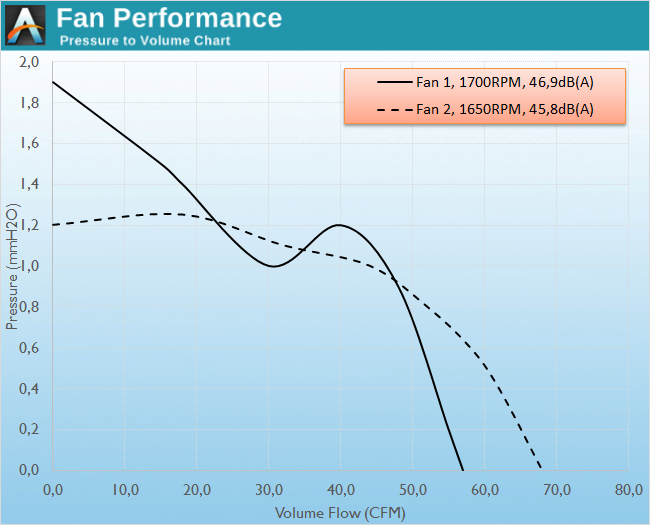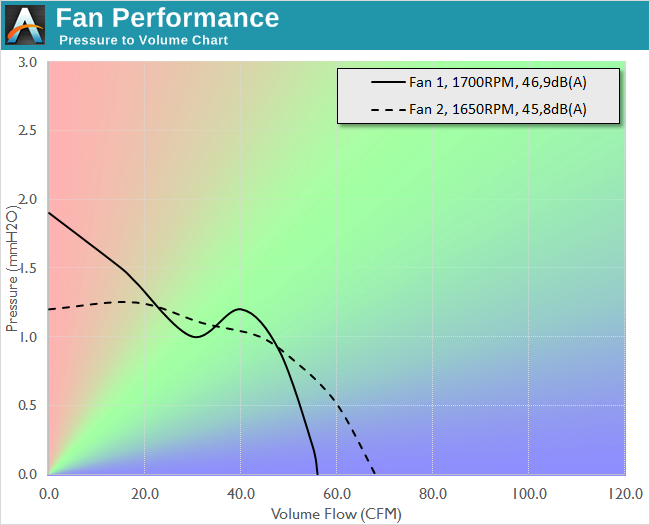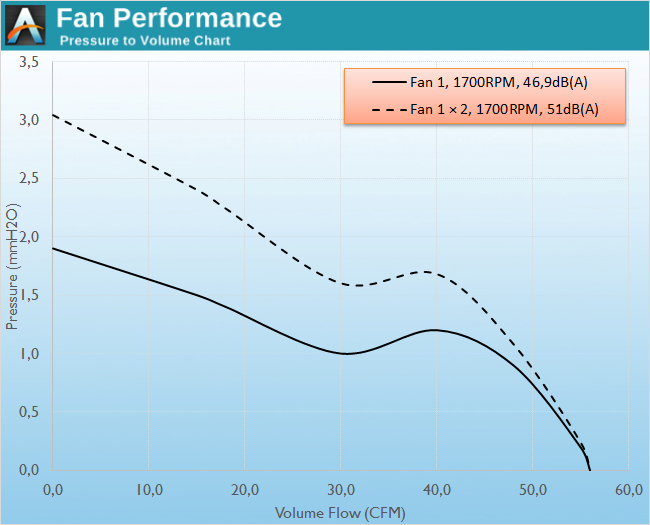The Corsair SP (Static Pressure), AF (High Airflow) 120/140mm Fan Review
by E. Fylladitakis on November 25, 2015 8:00 AM ESTFan Testing Methodology
For our first fan review we want to talk about the performance of fans and discuss how we will be testing them in our upcoming articles. This will serve as both a reference point for readers and manufacturers, as well as a chance to receive feedback and input on what we're doing before our first roundups start coming out. A large percentage of computer users are unconcerned with the actual performance of any given fan; most base their choices on recommendations and are swayed by marketing claims of "noiseless operation" and "astounding performance". Advanced users and enthusiasts are using up a lot of grey matter on the topic, seeking to find the best possible solution over dozens of possible choices. Regrettably, even if the user possesses the will and the knowledge to select a product suitable for his/her needs, they are often limited to the manufacturer's specifications, which usually are vague at best.
The fan manufacturers typically provide only a few performance figures, such as the static pressure and maximum volume flow ratings of a fan. However, even if these figures are 100% accurate (and they frequently are not), they are entirely useless to the end consumer. There are many who believe that a high static pressure rating is good for coolers and a high volume flow rating is good for case fans, but this is far from accurate. Maximum static pressure is taken at zero volume flow and maximum volume flow means zero static pressure; either scenario is impossible under real-world conditions. Furthermore, the maximum volume flow is usually calculated from the maximum velocity recorded at the exit of the fan. This is also entirely unrealistic as the fluid flow will definitely not be even across the entire exit area of the fan. The result is that retail products tend to have actual volume flows significantly lower than their specified maximum CFM ratings.
To measure the actual performance of a fan, the user has to know the P-Q (pressure to volume) chart of the fan. Here we measure the amount of applied pressure restriction, measured in mmH2O (where 1 mm H2O is the equivalent of 9.81 Pascals - one Pascal is the pressure required to accelerate 1 kg of mass at a speed of 1 meters per second squared per square meter) required to give a specific volume flow (measured in cubic feet per minute or CFM). The more the flow is restricted, the less volume flow is generated and the higher the pressure of the fan is. Still, some of the computer users who actually know how to interpret a P-Q chart are frequently misconceived that a P-Q chart is depicted by a straight line, such as this:
This is the misconception about pressure to volume - reality is a non-linear response
Unfortunately, this could not be further from the truth. The shape of the curve varies between the maximum static pressure and maximum volume flow rating, depending on several dozens of factors, mainly having to do with the design of the blades and the torque (the pushing power) of the engine. As such, two near-identical fans can have completely different behavior, which can be muddied by the actual 'naming' of the fan as an added element of confusion.
For example, the following chart depicts the P-Q chart of two fans. The first fan has a higher static pressure rating than the second and they both have an equal maximum volume flow (on paper), yet the second fan is a better selection for use as a case fan as it performs better when there are few obstructions.
Fan 2 is preferred in low impedance scenarios (low mmH2O)
as it gives higher airflow (>60 CFM under 0.6 mmH2O)
Unfortunately, the calculation of the impedance (resistance to move air) the fan will face by a grill/cooler/radiator/filter can be very difficult to assess without specialized equipment. It can be measured but it depends on far too many variables, including several environmental figures, such as the temperature and the air density. Even if we did extract a specific graph for every single part, the actual graph would be different for every single user. Therefore, it is not practical to give a graph depicting the exact impedance that an item has. It is however possible to provide an usable estimate, which we will be doing so in our future cooler and radiator reviews. The impedance of different items that can restrict the airflow looks like this:
Where the impedance line intersects with the fan's performance curve, that's where the fan will operate.
So a low impedance item generates 0.3 mm H2O of pressure and hits the fan curve at ~63 CFM in this case.
The green line depicts a high impedance item, such as a very dense liquid cooling radiator. The purple line is for a medium impedance item, such as a cooler. The black line is for a low impedance application, such as a case fan with a simple finger guard or a clean filter. For example, the medium impedance item in the graph above would have the fan moving about 32 CFM. There are no actual conditions under which the actual performance of a fan will go very near its maximum static pressure point nor will a fan will reach its maximum volume flow. This allows us to provide a usable estimate when testing coolers, radiators and similar devices. For example, a "very high impedance" radiator would lean towards the left side of the red area, while a "medium to low impendance" cooler would lean towards the right side of the green area.
Where the impedance line intersects with the fan's performance curve, that is the aiflow impedance pressure drop, or by how much of a pressure drop the device (cooler, radiator, filter, etc.) will cause to a fan. Note that the impedance line is highly unlikely to intersect at the same airflow impedance pressure drop point for different fan performance curves. As such, the pressure drop is not something that can be universally assessed for each application but depends on the fan itself as well.
We will be using the above style of graph for the delivery of our results, maintaining the same axes for 120mm/140mm fans for easy comparisons. The red, green and blue areas should be consulted for high, medium and low impedance applications respectively. Even if the axes do shorten, note that the areas remain nearly identical if the range of both axes is reduced by the same percentage.
When the expected obstruction is high, some manufacturers use two fans in series (a push-pull configuration). This is often the case with liquid-cooling radiators. When two fans are placed in series, their pressure at a given airflow is increased (but not doubled) and thus the airflow at a given pressure point is increased, as seen in the following example.
Using two fans in a push/pull configuration.
Thus at a static pressure of 1.5 mmH2O (medium impedance device, such as an air cooler), volume flow increases here from 15 CFM to 43 CFM. However, their maximum airflow will always be the same; therefore, this approach makes no sense when the impedance is low and only in high static pressure situations.
How AnandTech Will Test Fans
We will begin testing fans using an Extech HD350 differential manometer with a Pitot tube, an Extech AN200 velocity meter, and a custom apparatus designed for this specific purpose. The apparatus has a mechanism that allows us to test the unobstructed (maximum) volume flow of a fan, the fully obstructed (maximum static) pressure of the fan, and multiple points in between, allowing us to compose the actual P-Q performance chart of any fan. However, we are measuring the actual airflow generated by the fan, not that calculated by our maximum recorded air velocity.
For noise measurements, we are using an Extech HD600 high sensitivity SPL meter. The noise of the fan is measured from 15 centimeters away, not one meter as IEC certifications require, as that would be far too great a distance to measure differences between nearly silent products. Note however that we are measuring the noise level of a fan with its flow unobstructed. The addition of far grills, the installation on a cooler, and any other form of obstruction will increase the generated noise, as aerodynamic noise will be added into the environment.
We also plan on testing fans at their "stock" 12 V PC voltage and at a lower voltage, which will most usually be 7 V. This may not always be practical on some fans (i.e. very low speed fans may have their performance degraded far too much), but when it is we will do so. While it's impossible to state how any fan will perform in every situation, we will be able to provide at least a more rigorous view of each fan's performance. In the meantime, any feedback on our approach to testing or requests for additional tests is welcome.















92 Comments
View All Comments
RdVi - Wednesday, November 25, 2015 - link
A nice introduction to a more in depth investigation of real world fan performance. I hope to see many more articles like this one with comparisons between brands where possible. Great work.Valantar - Thursday, November 26, 2015 - link
Agreed, this was an interesting and informative read. Looking forward to some comparisons, especially high-end brands like Noctua, to see what value you're actually getting from the extra outlay.maximumGPU - Wednesday, November 25, 2015 - link
Thank you for setting the record straight in regards to the LED models. At first look anyone could be fooled that these are the standard models with some led's strapped in.inighthawki - Wednesday, November 25, 2015 - link
With that in mind, is there a reason the LED versions are built differently? That is, the article mentions the difference in the fan blades, but I'm wondering why there is a difference.ninjaquick - Wednesday, November 25, 2015 - link
Ask Corsair.tipoo - Wednesday, November 25, 2015 - link
Just a misanthropic guess, but saving pennies to make up for the LED?TheKiwi - Thursday, November 26, 2015 - link
I actually asked (well, kinda angrily ranted) at a Corsair product manager on IRC about that once. Basically, people buying LED fans don't care about high-end performance as much. There's no market for high-end LED fans.I think it's dumb, but they probably have market research to back it up.
Barbarossa - Thursday, December 3, 2015 - link
Corsair George here - this is pretty close to right, or at least it was at the time of the product dev 2-3 years ago. When we started doing fans in 2012 we had no data that proved that "high cost" LED fans sold at all. Basically, if it had LEDs in it, nobody paid a premium. At the time the best fans were Noctua or Scythe, neither of which used LEDs.So when we decided to do performance LED fans, we focused on making them perform very well for their price. Note that the LED fans do not include the swappable color rings or the rubber corners or the hydraulic bearings - all cost saving measures because LED fans had to cost significantly less.
Nowadays, with a few more higher-cost LED options, we are somewhat rethinking that.
I think there's room for a truly high performance LED fan out there - if it doesn't look and feel cheap.
Also, it's been almost 4 years since we released the SP / AF performance fans - I think we're about due for something new.
Phreedom1 - Sunday, December 6, 2015 - link
Awesome explanation George. Hope Corsair does come out with a new fan product.rscsrAT - Wednesday, November 25, 2015 - link
It's nice to see a fan review again.But I think that the presentation is awful. You should add scale lines for the different cooler types instead of the color gradients. Then it would actually be useful.
And the word impedance should be limited to electrical resistance. I am studying mechanical engineering and I haven't heard impedance once (in fluid dynamics). It is usually refered as resistance (or drag for bodies in free flow).